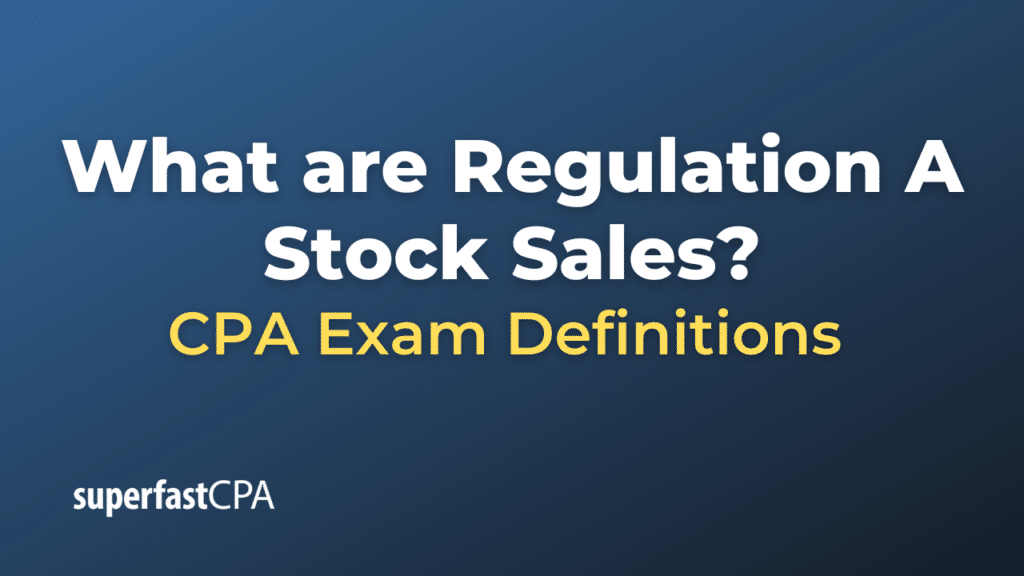Regulation A Stock Sales
Regulation A is an exemption from registration requirements instituted by the Securities Act of 1933, allowing companies in the U.S. to raise capital from the public without undergoing the full registration process with the Securities and Exchange Commission (SEC). It’s often referred to as a “mini-IPO” because it allows smaller companies to access public markets for capital without the same level of regulatory burden as a traditional IPO.
Regulation A stock sales are broken down into two tiers:
- Tier 1: Allows companies to raise up to $20 million in a 12-month period. Requires certain financial statements, but they don’t need to be audited. Companies conducting a Tier 1 offering must also undergo a coordinated review of the offering with the states in which they intend to offer or sell securities.
- Tier 2: Allows companies to raise up to $75 million in a 12-month period. Requires audited financial statements and ongoing reporting obligations, but it preempts state registration and qualification, meaning companies don’t have to register or qualify their securities in any state where they want to offer or sell them, as long as they meet the requirements.
Key Features of Regulation A Stock Sales:
- Eligibility: Regulation A is available to U.S. and Canadian companies that are not SEC-reporting entities. Certain other companies, such as investment companies, are also not eligible.
- General Solicitation: Companies can advertise and solicit their offering to the general public, unlike other exemptions.
- Investment Limitations: For Tier 2 offerings, non-accredited investors (generally, individuals who don’t meet specific income or net worth criteria) are limited in how much they can invest, based on a percentage of their income or net worth.
- Online Platforms: Many Regulation A offerings take place online, using platforms dedicated to raising capital in this manner.
- Resale Restrictions: Securities sold under Regulation A are not “restricted securities,” and thus are freely tradable in most cases.
- State Securities Laws: As mentioned, Tier 1 offerings require state review, but Tier 2 offerings preempt state registration and qualification.
- Ongoing Reporting: Companies that conduct a Tier 2 offering have some ongoing reporting obligations, including semiannual and annual reporting, as well as current event reporting.
Regulation A provides a more streamlined and cost-effective method for smaller companies to raise capital from the public. However, companies still need to be mindful of the requirements and engage with legal and financial professionals to ensure compliance.
Example of Regulation A Stock Sales
Let’s consider a hypothetical scenario where a company decides to utilize Regulation A to raise funds.
DreamDrones, a company specializing in drone technology for agriculture, has been operating for several years with steady growth. DreamDrones wants to raise funds to expand its operations and enter new markets. However, the traditional IPO process is daunting and might be overkill for the amount they’re looking to raise. After consulting with their advisors, they decide that Regulation A is the right route for them.
- Determine the Tier: DreamDrones wants to raise $30 million, which places them in the Tier 2 category.
- Preparation: DreamDrones works with its legal and financial advisors to prepare the offering circular, which is akin to a prospectus in an IPO. Since they’re opting for a Tier 2 offering, they ensure their financial statements are audited.
- Filing with SEC: They submit their offering circular to the SEC for review.
- Awaiting Qualification: The SEC reviews the offering, and after some rounds of comments and adjustments, they qualify DreamDrones’ offering.
- Marketing: Given the allowance for general solicitation under Regulation A, DreamDrones launches a comprehensive marketing campaign, including online advertisements, to reach potential investors. They also use an online platform dedicated to Regulation A offerings to reach a broader audience.
- Raising Capital: Investors, attracted by the potential of drone technology in agriculture and the compelling case presented in the offering circular, invest in DreamDrones. Some of these investors are non-accredited and appreciate the opportunity to invest in a growth-stage company, which might not have been possible with other types of offerings.
- Completion: DreamDrones successfully raises the $30 million, and the investors receive their shares.
DreamDrones has the capital it needs to expand its operations without undergoing the more intensive and costly process of a traditional IPO. Investors, both accredited and non-accredited, have a stake in a promising company in a burgeoning sector. The company has some ongoing reporting requirements because they went with Tier 2, but they’re prepared for that, given the benefits they received from using Regulation A.
This example underscores how Regulation A can provide a middle ground for companies that want to access public capital markets but aren’t yet ready or don’t see the need for a full-blown IPO.













